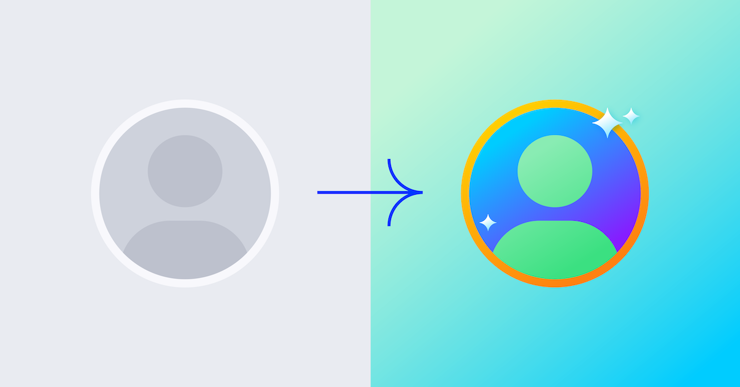How do I get started with personalization? Three simple strategies for immediate impact


It's no secret that personalization is more important than ever. According to a 2021 McKinsey & Company report, 71% of consumers expect companies to deliver personalized interactions. And 76% get frustrated when this doesn't happen.

Plotting out your personalization strategy can feel overwhelming when you're starting from scratch (or even when you're not).
Relax, we've got you covered! Here we'll walk you through some simple tips to help you get started with building and implementing a personalization strategy that will help you drive engagement, boost conversions, and delight your customers.
Understanding the basics: What is personalization?
First up, let's make sure we're on the same page with the foundations. Personalization involves tailoring marketing efforts to individual customers based on their preferences, behaviors, and data. It's about delivering the right message at the right time.
Full rundown: What is personalization?
Why is personalization important?
Personalization:
- Improves customer experience
- Increases engagement and conversion rates
- Enhances customer loyalty and retention
- Enables a more efficient use of marketing personas
Getting started with personalization
When getting started with personalization, brands often get stuck on who to target, with what kind of experiences. These best practices can help combat overwhelm and get you on the right track:

#1 - Lead with your personas
Has your business built a clear ideal customer profile (ICP), or identified target buyer personas? If so, start by ideating personalization campaigns against those personas. This ensures that your strategies are grounded in a solid understanding of your target audience. Don't have target buyer personas in place, or are they in need of a refresh? Hubspot has a step-by-step guide and free templates to help walk you through the process.
#2 - Target your broadest audiences
Another option is to start with your broadest audience segments, such as:
- Prospects vs. customers
- First-time buyers vs. repeat buyers
- Desktop vs. mobile
As you gather more data and insights, you can refine your approach and create more granular personalization strategies.
#3 - Prioritize relevant customer experiences
Focus on delivering personalization experiences that truly matter to your customers. According to McKinsey (again), 68% of consumers expect relevant product/service recommendations, so factor in behavioral data and look for opportunities to make recommendations based on interest/intent.
Personalization examples
Let's dive into some personalization examples by a few key verticals: retail, banking and travel.
Retail personalization: Turning browsers into buyers
In the hyper competitive world that is retail, personalization can be the key to standing out and driving conversions. Here are three powerful strategies to tailor your customer experience:
#1 - Behavioral targeting. Behavioral targeting shows visitors a personalized experience based on their real-time behavior and interactions with your site.
Test + Learn: Experimentation
There are countless ways to apply behavioral targeting. For instance, brands can use behavioral targeting to target customers who previously bought handbags over $400 in the past 30 days with special promotions on select products to compliment their handbag purchases.
#2 - Symmetric messaging. When you use symmetric messaging, you're setting expectations in ad and email campaigns that match website experiences. When visitors click from an ad hosted on a search engine, social network, or third-party site to your page, the CTA, messaging, and imagery they see on your site matches their ad experience.
Example: An activewear company sends customers an email promotion about a two-day discount on yoga gear. When a customer who received the promotion visits their website, they see yoga products in the homepage header, and a banner displaying the discount code.
#3 - Category affinity. You can use previous browsing behavior to understand visitors' preferences and show preferred product categories later in their journey, or during future visits. (Tip: You can do this in Optimizely by using existing events to target based on existing page views and more.)
Example: A customer visits a specific product page twice in one week, and when they return to the homepage, they see imagery, a CTA, or offers related exclusively to the product.
Banking and financial services personalization
In the banking world, tailored recommendations and offers go a long way in delivering even more value, helping financial institutions build trust and loyalty among their customer base.
#1 - Personalized savings goals. Offer personalized savings goals and recs based on financial situation and spending habits. A bank's mobile app, for example, can analyze a customer's transaction history and suggest personalized savings targets for milestones such as vacation, home purchase, or emergency fund.
#2 - Custom referral program offers. Offer tailored incentives to a referring customer and the referred customer when they complete a specified action, such as making a qualifying deposit, opening an account, or signing up for a credit card.
#3 - Dynamic loan offers. Test different loan offers and terms to optimize conversion rates based on a customer's credit score, income level, and financial goals. You can experiment with options such as lower interest rates, extended repayment terms, etc.
Travel personalization
Airlines, hotels, and resorts can optimize the booking experience and provide personalized recommendations to drive revenue.
#1 - Tailored booking recommendations. Analyze past booking history, preferences, and browsing behavior to personalize booking recommendations. Example: For a passenger who frequently travels to tropical locations, airlines can surface flight deals to popular beach destinations.
#2 - Dynamic pricing and packaging. Conduct A/B tests to determine the most effective pricing strategies for different customer segments (discounted fare, bundles, unlocking loyalty rewards). Test different pricing and package offers (i.e. Honeymoons, mid-week stays, buy 3 nights get the 4th free, included resort credits or experiences etc.) to maximize revenue and occupancy rates. Factor in booking lead times, demand trends, and guest preferences.
#3 - Booking experience. Test different versions of the booking process (for example, website and app layouts, CTAs, or pricing) to optimize conversion rates based on loyalty status/frequent flyers, or booking history & preferences.
How to overcome key personalization challenges
- Data collection and management: Implement robust data collection and management practices to ensure you have accurate, up to date information to fuel your personalization efforts.
- Balance personalization and privacy: Be transparent about your data collection and usage policies, and always prioritize customer privacy. Offer clear opt out policies, and adhere to relevant data protection regulations.
- Avoiding over-personalization: Strike a healthy balance between over-personalization and user comfort. Avoid being overly intrusive or making customers feel uncomfortable.
- A/B testing and personalization: Continuously test and optimize your personalization strategies through A/B testing and experimentation. This will help you identify what works best for your audiences and maximise the impact of your efforts.
Conclusion
Getting started with personalization can seem overwhelming, but it's a crucial step in meeting modern consumer expectations and driving digital growth. By following these simple steps outlined in this article - leading with personas, targeting broad audiences initially and prioritizing relevant experiences - you can build a solid foundation for your personalization efforts.
Remember that personalization is an ongoing process of learning and optimization. Start with the basics, track your results, and continuously refine your approach based on data and customer feedback. As you implement these strategies across different touchpoints and industries, you'll not only answer the question 'How do I get started with personalization?' but you'll unlock new opportunities for engagement, conversion and customer loyalty.
With the right tools, strategies and mindset, you can create a personalization program that delivers meaningful results and sets your brand apart from your competitors.
Ready to learn more? Check out these resources to help you take that next step:

